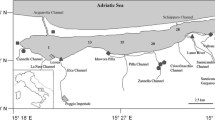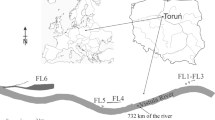Abstract
Seasonal fluctuation in river stage strongly affects the ecological functioning of tropical floodplain lakes. This study was conducted to assess the influence of hydrological seasonality on bacterial production and abundance in two floodplain lakes of the Autana River, a blackwater river in the Middle Orinoco basin, Venezuela. Water samples for nutrient chemistry, chlorophyll a, and microbiological determinations were collected in two floodplain lakes and in the mainstem of the river during 1997–98. DOC and chlorophyll a concentrations were similar between mainstem and lake sites during high water when river and lakes were well connected but became different during the period of low water when the interaction was minimal. Higher values of bacterial production were observed in the floodplain lakes (0.62–1.03 μg C l−1 h−1) compared to the mainstem sites (0.17–0.19 μg C l−1 h−1) during the period of low water, while during the period of high water river and lake sites showed similar levels (0.04 μg C l−1 h−1). Bacterial numbers followed bacterial production in the floodplain lakes, reaching higher numbers during the period of low water (1.41–2.40 × 106 cells ml−1). Availability of substrate and inorganic nutrients, pH, and inputs and losses of bacterial cells could be determining the observed seasonal patterns in bacterial production and abundance. The Autana lakes exhibited a strong seasonal pattern in the chemical and biological conditions, showing higher productivity during the lentic phase that lasted between 5 and 6 months.
Similar content being viewed by others
References
A. P. H. A., 1992. Standard Methods for the Examination of Water and Wastewater. APHA, Washington, D.C: 1268 pp.
Amon, R. M. W. & R. Benner, 1996. Photochemical and microbial consumption of dissolved organic carbon and dissolved oxygen in the Amazon River system. Geochimica et Cosmochimica Acta. 60: 1783–1792.
Anesio, A. M., P. C. Abreu & F. de Assis Esteves, 1997. Influence of the hydrological cycle on the bacterioplankton of an impacted clear water Amazonian lake. Microb. Ecol. 34: 66–73.
Bayley, P. B., 1995. Understanding large river-floodplain ecosystems. BioScience 45: 153–158.
Bertilsson, S. & B. Allard, 1996. Sequential photochemical and microbial degradation of refractory dissolved organic matter in a humic freshwater system. Arch. Hydrobiol. Spec. Issues Advanc. Limnol. 48: 133–141.
Bonetto, A. A. & I. R. Wais, 1995. Southern South America streams and rivers. In Cushing, C. E., K. W. Cummins & G. W. Minshall (eds), River and Stream Ecosystems. Elsevier, Amsterdam: 257–293.
Cole, J. J., S. Findlay & M. L. Pace, 1988. Bacterial production in fresh and saltwater ecosystems: a cross-system overview. Mar. Ecol. Prog. Ser. 43: 1–10.
Coveney, M. F. & R. G. Wetzel, 1988. Experimental evaluation of conversion factors for the [3H] thymidine incorporation assay of bacterial secondary productivity. Appl. envir. Microbiol. 54: 2018–2026.
Edling, H. & L. R. Tranvik, 1996. Effects of pH on ß-glucosidase activity and availability of DOC to bacteriain lakes. Arch. Hydrobiol. Spec. Isues. Advac. Limnol. 49: 123–132.
Ertel, J. R., J. I. Hedges, A. H. Devol & J. E. Richey, 1986. Dissolved humic substances of the Amazon River system. Limnol. Oceanogr. 31: 739–754.
Furch, K., 1984. Water chemistry of the Amazon basin: The distribution of chemical elements among freshwaters. In Sioli, H. (ed.), The Amazon: Limnology and Landscape Ecology of a Mighty Tropical River and its Basin. Dr W. Junk Publishers, Dordrecht: 167–199.
Hamilton, S. K. & W. M. Lewis, Jr., 1987. Causes of seasonality in the chemistry of a lake on the Orinoco River floodplain, Venezuela. Limnol. Oceanogr. 32: 1277–1290.
Hamilton, S. K., S. J. Sippel, W. M. Lewis, Jr. & J. F. Saunders, III, 1990. Zooplankton abundance and evidence for its reduction by macrophyte mats in two Orinoco floodplain lakes. J. Plankton Res. 12: 345–363.
Hobbie, J. E., R. J. Daley & S Jasper, 1977. Use of nucleopore filters for counting bacteria by fluorescence microscopy. Appl. envir. Microbiol. 33: 1225–1228.
Junk, W. J. & G. E. Weber, 1995. Amazonian floodplains: a limnological perspective. Verh. int. Ver. Limnol. 26: 149–157.
Junk, W. J., P. B. Bayley & R. E. Sparks, 1989. The flood pulse concept in river-floodplain systems. In Dodge, D. P. (ed.), Proceedings of the International Large River Symposium. Can. Spec. Publ. Fish. Aquat. Sci. 106: 110–127.
Kirchman, D. L., 1993. Leucine incorporation as a measure of biomass production by heterotrophic bacteria. In Kemp P. F., B. F. Sherr, E. B. Sherr & J. J. Cole (eds), Handbook of Methods in Aquatic Microbial Ecology. Lewis Publishers, Boca Raton (FL): 509–512.
Lasi, M. A., 1984. Estudio Comparativo de las Variaciones de Masa y Dinámica Metabólica de la Materia Orgánica Particulada Suspendida en dos Rios Rributarios del rio Orinoco, Territorio Federal Amazonas. Licenciatura's Thesis, Universidad Simón Bolívar, Venezuela.
Leenheer, J. A., 1980. Origin and nature of humic substances in the waters of the Amazon river. Acta Amazonica 10: 513–526.
Lewis, W. M., S. K. Hamilton & J. F. Saunders III, 1995. Rivers of Northern South America. In Cushing, C. E., K. W. Cummins & G. W. Minshall (eds), River and Stream Ecosystems. Elsevier, Amsterdam: 219–256.
Lewis, W. M., Jr., J. M. Melack, W. H. McDowell, M. McClain & J. E. Richey, 1999. Nitrogen yields from undisturbed watersheds in the Americas. Biogeochemistry 46: 149–162.
Lindell, M. J., W. Granéli & L. J. Tranvik, 1995. Enhanced bacterial growth in response to photochemical transformation of dissolved organic matter. Limnol. Oceanogr. 40: 195–199.
Marker, A. F., E. A. Nusch, H. Rai & B. Reimann, 1980. The measurement of photosynthetic pigments in freshwaters and standardization of methods: conclusions and recommendations. Arch. Hydrobiol. Beih. Ergebn. Limnol. 14: 91–106.
Meyer, J. L., 1994. The microbial loop in flowing waters. Microb. Ecol 28: 195–199.
Meyer, J. L., R. T. Edwards & R. Risley, 1987. Bacterial growth on dissolved organic carbon from a blackwater river. Microb. Ecol 13: 13–29.
Moran, M. A. & R. E. Hodson. 1990. Bacterial production on humic and nonhumic components of dissolved oganic carbon. Limnol. Oceanogr. 35: 1744–1756.
Morris, D. P. & E. M. Lewis, Jr., 1992. Nutrient limitation of bacterioplankton growth in Lake Dillon, Colorado. Limnol. Oceanogr. 6: 1179–1192.
Montoya, J. J. 1999. Es </del>Abundancia y biomasa del bacterioplancton en la cuenca baja del Río Caura, Edo. Bolívar, Venezuela. Licenciatura's Thesis, Universidad Simón Bolívar, Caracas, Venezuela.
Münster, U. & R. Chróst, 1990. Origin, composition, and microbial utilization of dissolved organic matter. In Overbeck J. & R. J. Chróst (eds), Aquatic Microbial Ecology. Springer-Verlag, New York: 8–46.
Neiff, J. J., 1995. Large rivers of South America: toward the new approach. Verh. int. Ver. Limnol. 26: 167–180.
Rai, H., 1978. Distribution of carbon, chlorophyll-a, and pheopigments in the blackwater lake ecosystem of Central Amazon Region. Arch. Hydrobiol. 82: 74–87.
Rai, H. & G. Hill, 1981a. Observations on heterotrophic activity in Lago Janauari: a ria/várzea lake of Central Amazon. Verh. int. Ver. Limnol. 21: 715–720.
Rai, H. & G. Hill, 1981b. Bacterial biodynamics in Lago Tupé, a central Amazonian blackwater 'Ria Lake'. Arch. Hydrobiol/ suppl. 58: 420–468.
Rai, H. & G. Hill, 1982. On the nature of the ecological cycle of Lago Janauari: a central Amazonian ria/várzea lake. Tropical Ecol. 23: 1–50.
Rai, H. & G. Hill, 1984a. Primary production in the Amazonian aquatic ecosystems. In Sioli, H. (ed.), The Amazon: Limnology and Landscape Ecology of a Mighty Tropical River and its Basin. Dr W. Junk Publishers, Dordrecht: 311–335.
Rai, H. & G. Hill, 1984b. Microbiology of Amazonian waters. In Sioli, H. (ed.), The Amazon: Limnology and Landscape Ecology of a Mighty Tropical River and its Basin. Dr W. Junk Publishers, Dordrecht: 413–441.
Sioli, H., 1984. The Amazon and its main affluents: hydrography, morphology of the river courses, and river types. In Sioli, H. (ed.), The Amazon: Limnology and Landscape Ecology of a Mighty Tropical River and its Basin. Dr W. Junk Publishers, Dordrecht: 127–165.
Sippel, S. J., Hamilton, S. K. & J. M. Melack, 1992. Inundation area and morphometry of lakes on the Amazon River floodplain, Brazil. Arch. Hydrobiol. 123: 385–400.
Tranvik, L. J., 1990. Bacterioplankton growth on fractions of dissolved organic carbon of different molecular weights from humic and clear waters. Appl. envir. Microbiol. 56: 1672–1677.
Tranvik, L. J., 1998. Degradation of dissolved organic matter in humic waters by bacteria. In Hessen D. O. & L. J. Tranvik (eds), Aquatic Humic Substances: Ecology and Biogeochemistry. Springer, Berlin: 259–283.
Villaró, M., 1997. Variaciones del Bacterioplankton y Carbono Orgánico Disuelto en dos Ríos del Edo. Amazonas. M.S. Thesis, Universidad Simón Bolívar, Caracas, Venezuela.
Weibezahn, F. H., 1990. Hidroquímica y sólidos suspendidos en el alto y medio Orinoco. In Weibezahn, F. H., H. Alvarez & W. M. Lewis, Jr. (eds), The Orinoco River as an Ecosystem. Galac, Caracas: 151–210.
Wetzel, R. G., 1995. Death, detritus and energy flow in aquatic ecosystems. Freshwat. Biol. 33: 83–89.
Wetzel, R. G., P. G. Hatcher & T. S. Bianchi, 1995. Natural photolisis by ultraviolet irradiance of recalcitrant dissolved organic matter to simple substrates for rapid bacterial metabolism. Limnol. Oceanogr. 40: 1369–1380.
Wetzel, R. G. & G. E. Likens 1991. Limnological Analyses. Springer-Verlag, New York: 391 pp.
White, P. A., J. Kalff, J. R. Rasmussen & J. M. Gasol, 1991. The effect of temperature and algal biomass on bacterial production and specific growth rate in freshwater andmarine habitats. Microbiol. Ecol. 21: 99–118.
Author information
Authors and Affiliations
Rights and permissions
About this article
Cite this article
Castillo, M.M. Influence of hydrological seasonality on bacterioplankton in two neotropical floodplain lakes. Hydrobiologia 437, 57–69 (2000). https://doi.org/10.1023/A:1026598123694
Issue Date:
DOI: https://doi.org/10.1023/A:1026598123694




